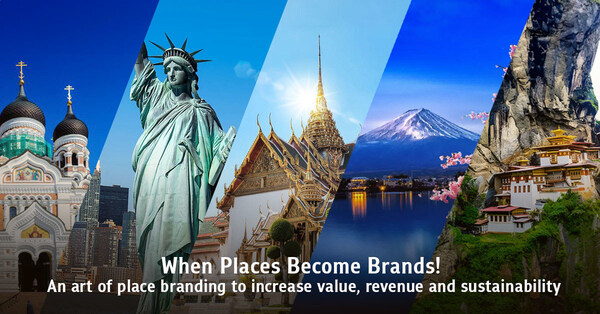Assistant Professor Ake Pattaratanakun from Chulalongkorn Business School, shares his insights on current place branding as a way to increase revenue, values and sustainability.
BANGKOK, Sept. 2, 2024 /PRNewswire/ -- Ban Thad Thong Road, this location recalled a home to sports shops and auto spare parts. Not anymore! Just in recent years, the 1.5-kilometre road has served as a vibrant culinary haven where local and foreign visitors frequent for gastronomical experience. Variety of street foods; traditional and fusion, coupled with attractive lighting and decor of the restaurants, have redefined and crafted a new identity of the area. A new hype, Ban Thad Thong Road is picked up by Time Out, a leading global media and hospitality business that inspires and enables people to discover and experience the best of the city, as one of the top 30 coolest street foods in the World.
"Ban Thad Thong is one of the areas in Bangkok that is successfully place branding for good street foods!" said Assistant Professor Ake Pattaratanakun, PH.D. (CANTAB), Head of Marketing and Director of the MBM (English), Chulalongkorn Business School at Chulalongkorn University.
"In today's globalized and urbanized world, cities and regions fiercely compete for talents, tourists, stakeholders, investors, and businesses. Places are no longer just geographical locations, but they become brands. A brand that shapes the identity of a place and builds its reputation. And this is where, place branding comes into full bloom."
What is Place Branding
Place branding is not similar to destination branding, Asst. Prof. Ake said. Destination branding is more about travelling, be they business travelling or leisure travelling. The practice of place branding, however, is strategic approach in shaping the identity and perception of a location or region, using its unique assets to enhance competitiveness and to foster economic growth.
Take for example, the famous "I love New York" campaign which was launched in 1977.
This is a good example of a successful place branding. It is considered to be one of the most successful tourism marketing campaigns that reinforces New York State's tourism industry, which at the time, was struggling its negative perceptions of its urban areas."
Asst. Prof. Ake continued, "The slogan is simple yet powerful, capturing a sense of pride and appeals to its residents and tourists. The city promotes its values; natural beauty, cultural richness and vibrancy of the New York State. The slogan sets direction and strong positioning when it comes to products, banners and souvenirs."
Not only a city, but a country can be also branded. "Amazing Thailand" is one such example, Asst. Prof. Ake pointed.
"The campaign was successful in positioning Thailand as a must visit place and a top tourist destination for travelers, showcasing values and assets of the country, such as, cultural heritage, nature, unique culinary experience and wellness, along with Thai people hospitality."
Place branding and Commodity
At times, place branding can be a boon to promote local commodities. Thailand's jasmine rice is a case in point. Assist. Prof. Ake said.
Thinking about premium jasmine rice, the name of "Thailand jasmine rice" will naturally come to mind as Thailand has successfully branded itself as a terrain best in cultivating and harvesting high-quality rice.
Another case is "Hokkaido milk".
"Japan has done a great job in turning place branding into a very good commodity endorser. The milk from Hokkaido has become a must-have commodity. Its value is increased and branded as premium, natural and healthy products. And not only milk, other products, such as famous Hokkaido scallops, fresh, clean, and creamy white meat, accentuate Japan's rich marine nature and location."
Place branding and Politics
Political standpoints of a country can be used as place branding as it shapes perceptions and enhance attractiveness of a country on the global map.
"Swiss neutrality is a good example," Asst. Prof. Ake said. "Switzerland has adopted neutrality as its key principle in foreign policy for a long time. Neutrality means Switzerland does not take sides in conflicts between other countries and aspires not to get involved in international disputes. Strategically, this makes Switzerland a safe and reliable destination for international and organizational events. In terms of commodity, Switzerland's emphasis on high end products and luxury goods such as watches and chocolates."
Policies of the countries can direct and influence place branding, and vice versa.
"Singapore government has succeeded in crafting the island identity as a global city-state for business, finance, and innovation in Asia, not to mention its iconic landmarks, such as, Marina Bay Sands and Gardens by the Bay. For many visitors and expats, Singapore is a place that exhibits safety, security, efficiency, cleanliness, and multi-culturalism."
Apart from Switzerland and Singapore, Asst. Prof. Ake added another interesting country – Estonia, a once poor country that is now become affluent.
"Estonia has become digitally modernized. Everything goes digital including their government and self-identification. Estonia attracts prospects with Estonian Digital Nomad VISA and invested in advanced digital infrastructure, e-governance, and tech-savvy working environment, making the country an attractive destination for remote workers looking for a seamless and affordable digital lifestyle"
Place branding – Powerhouse of Values
Place branding can be about anything; people, commodities, products or even political stance, that are associated with the locations and places.
"At the end of the day, place branding is a powerhouse of values. It even can become a soft power when the stories associated with the places shape the perceptions of people, and impacts local, international relations as well as economic development," Asst. Prof. Ake concluded.
Successful place branding would bring about 3 benefits; increase in revenue, reduce cost and attract good resources or investments, Asst. Prof. Ake added.
"Place branding makes use of its local talents, attractions, local events, cultural experiences and so on. This enhances local productivity. Goods and services are produced efficiently, while costs are reduced. When a place becomes productive, revenue naturally comes in."
The 6 Es Principles in Place Branding
Asst. Prof. Ake suggested six principles, referred to as "the 6 Es" to create a meaningful and successful place branding.
1. Ethical Governance – Asst. Prof. Ake explained that the practice of place branding should embrace strong ethics and morals, as well as avoid conflicts of interest; so as to establish ethical behavior and integrity among stakeholders.
2. Equity of Place Brand – This is referred to a "collective perception and reputation" of a place which constitutes the sum of all perceptions, associations, and attributes that it holds. It encapsulates the whole image and reputation of a place as perceived by stakeholders which drives its competitiveness and attractiveness.
3. Economics – "If you have a good place, you will achieve good economics." Asst. Prof. Ake added. This simply means that the economic success or progress of a place is linked to a geographical location. Good economics involve understanding and capitalizing on the different economic principles, market systems, policies, supply and demand, consumer behavior, among others that influence the success, from individual markets to global economies.
4. Good Environment – A good environment plays a vital role in showcasing a place's overall appeal. It's attractiveness and livability contribute a lot to its place branding and can attract businesses and stakeholders looking for a place that appeals to environmentally conscious consumers.
5. Good Ethno-Cultural – Cultural and ethnic diversity can significantly help a place develop its identity and attractiveness. It involves good people with good culture. A community with an ethno-cultural predicament that celebrates its vibrant story attracts visitors and stakeholders.
6. Eudaemonics – An ancient Greek word sometimes anglicized as "eudaemonia" or "eudemonia" which means the state or condition of 'good spirit' and commonly translated as 'happiness' or 'welfare'. According to Prof. Ake, this refers to the well-being of the people in the long run. It's the art or theory of happiness or having a meaningful life. With eudemonics, it helps to create an environment that supports the growth of residents, visitors and stakeholders alike thereby enhancing the attractiveness and competitiveness of a place in a global context.
Asst. Prof. Ake said that these 6 elements work hand in hand in creating a distinct brand for a place that influences perceptions and decisions of stakeholders ranging from tourists and investors to residents and policymakers.
"Sometimes brands might not be built strategically, it is built accidentally. Bangkok for example, it was built accidentally – "Bangkok is the place of diversity and growth" wherein no one judges each other based on the sum of perceptions."
Place Branding a means to Sustainability
Place branding can enhance places' reputation, increase revenue, attract investment, improve residents' satisfaction, but most importantly, it should promote a sustainable future of a place.
"Sustainability" should be the means and ends of place branding", Asst. Prof. Ake pointed.
"Successful place branding should be about engagement. There should be balance between locals, stakeholders and the environment. Some places in the world found their values at the end of the process and might not be always about money."
"Bhutan as an example. It promotes Gross National Happiness rather than focusing on GDP which measures the monetary value. In the end, what matters is not the money, but happiness," he added.
Steps for a Successful Place Branding
Place branding is a dynamic concept. The process and effects may be long term which requires our readiness to adapt and change.
"The needs of the stakeholders are dynamic, and you can't use the same branding again and again. You need to keep re-branding effectively. A brand may be popular now, the next day, it may not. Moreover, you need to re-educate new generations about the values of the place."
Asst. Prof. Ake shared a step-by-step process towards a successful place branding.
1. Don't start from the brand, start from identifying your target stakeholders.
2. Understand the needs of the locals and the stakeholders in terms of the roles they play, such as wisdom and culture. The environment and nature can also play some roles and these roles affects their behavior.
3. Identify core values of the place.
4. Identify core values of competitors or competitive places.
"Considering stakeholders, place, and competitors, you will realize the value of your place that is different from your competitors, and thus enable you to serve your stakeholders on point."
"Finally, an effective place branding requires a thorough understanding of a location's strengths, weaknesses, goals, and values, as well as careful consideration of the perceptions and expectations of the target audiences." Asst. Prof. Ake concluded.
For the full release and more images, please visit: https://www.chula.ac.th/en/highlight/181782/
About Chulalongkorn University
Chulalongkorn University has made the world's top 50 university list for employment outcomes, which reflects both the high employment rate and workability of Chula graduates. The university is also listed as the best in Thailand for the 15th Consecutive Year (since 2009), according to the newly released QS World University Rankings 2024, putting Chula at 211th in the world, up from 244th last year.
Social Media:
Facebook: https://www.facebook.com/ChulalongkornUniversity
Youtube: https://www.youtube.com/chulauniversity
Linkedin: https://www.linkedin.com/school/15101896/
source: Chulalongkorn University
想要獨家投資理財Tips?即Like etnet 全新Facebook專頁► 立即讚好
































